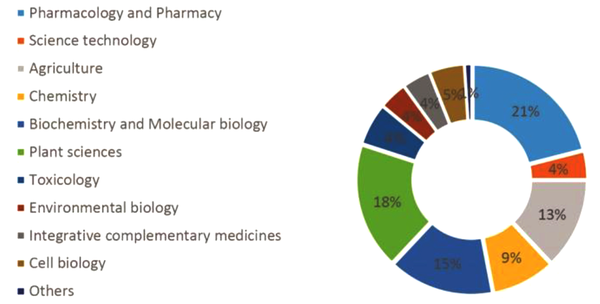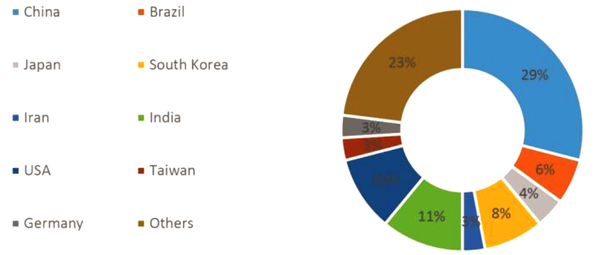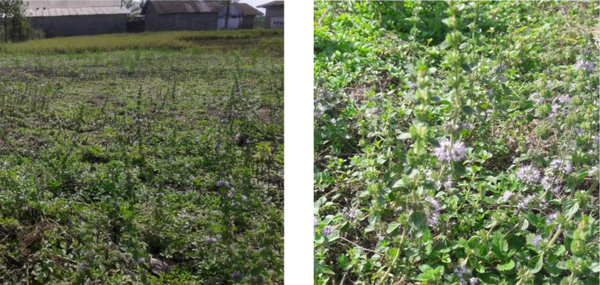1. Background
For many years, progressive human applications, quick industrialization, and new technologies in agriculture have caused the additive toxicity of elements and their contamination in natural and environmental sources, causing increased poisoning for bio-diversities (1, 2). Vast regions have shown contamination with toxic elements caused by pesticides, fertilizers, compost residues, and heavy metals from factories and mines (3). Toxic elements are introduced as contaminants in the environment and regarded as dangerous materials causing health problems. Lead, cadmium, mercury, and other distinguished ones include the most remarkable metals. Comprehensive technologies and everyday activities have demonstrated an additive amount of toxic elements in many sources (water, air, and soil), and generally, some elements are being collected by some bio-organisms and enter the food chain (4). Toxicology-oriented journals do not seem to have worked so comprehensively, and research in this area requires further research (Figure 1) (5). It was also indicated that developing countries like Iran do not have their actual place in research and sale despite the rich sources of medicinal plants (Figure 2) (5).
Human activities increase the amount of heavy metals pollution in the environment (6). Due to compounds that do not have metabolization roles in the body, they should be known as something with storage ability in body tissues such as muscles and bones. Toxic metals can cause mental retardation, hearing impairment, immune system dysfunction, brain diseases, blindness, muscle weakness, and cancer (7-16). The main characteristics of heavy metals are toxic aspects to the living organisms, and even those mentioned as essential can be toxic if present in excess. Human activities add to the toxic metals pollution in the natural systems. Toxic metals cause some diseases such as cancer, and the healthcare budget of some regions is allocated to cure and treat these diseases, besides expenses on the future of children (17-20).
Ziziphora persica, known as kakouti (21), is extensively distributed in Iran, especially in Guilan. As known, some of its parts like stems, leaves, and flowers are applied as a wild-type herb in the food menus because of its aromatic compounds and taste. In traditional Iranian medicine, the Ziziphora species has shown many advantages (carminative, sedative, and stomachic) compared to others (22). The Ziziphora L. genus is a member of the Lamiaceae family, with four species (Z. clinopodioides, Z. capitata, Z. persica, and Z. tenuior) distributed to all parts of Iran, especially northern Iran (23). Despite the dangerous effects of toxic elements on the body, a few of them, such as Cu and Zn, are necessary for normal physiological functions of our body system.
2. Objectives
In this study, we tried to show the importance of toxicity in foods, especially herbs, which makes some issues related to humans in northern Iran. Besides, in this research, the concentrations of heavy metals such as Pb, Zn, Hg, Cu, and Cd in the dried herb Ziziphora as one of the herbs in Lahijan (northern Iran) were studied using a flame atomic absorption spectrophotometer (FAAS).
3. Methods
3.1. Sampling
A total of 20 random samples of whole powdered Ziziphora (Ziziphora persica) were gathered from local markets in Lahijan, northern Iran (Figure 3). The samples were gathered from their original positions and packed in clean-checked polyethylene bags. Then, we started labeling, carried them to the lab, and kept them in the refrigerator until analysis.
3.2. Preparation, Digestion, and Analysis of Samples
The unwashed collected samples were dried at around 600°C for 24 hours in this research. Then, we made them into powder and mixed them to have a uniform mixture. The chemical materials used for digestion included HNO3 (nitric acid) (65%), ClH3O (hydrochloric acid) (37%), H2O2 (hydrogen peroxide) (30%), and KCl (potassium chloride). We also applied distilled deionized water for sample dilution. The solutions applied for FAAS calibration were the Merck standard solutions of the studied elements. Next, we used a Berghoff MWS-2 microwave digestion system to digest dried plant samples in an acidic solution. The dried samples of around 200 mg were used in the digestion vessels containing 8 mL HNO3 and 10 mL H2O2. Digestion lasted around 30 min and the vessels were cooled at room temperature. Then, each solution volume was made up to 50 mL for each sample using deionized water. Analysis was done on all samples using the FAAS method to detect Pb, Cd, Cu, Zn, and Hg (23-26).
3.3. Quantitative Determination of Toxic Metals
According to the following equation, the Hg, Cd, Zn, Pb, and Cu accumulations were determined in the analyzed samples.
mg/kg in assessed samples = A×B/W
A = mg/kg of the metal in the prepared sample (obtained by calibration)
B = Final volume of prepared sample in mL
W = Weight of sample in g
3.4. Statistical Analysis
Minimum, maximum, mean, and standard error were evaluated following Petrie and Watson (27).
4. Results and Discussion
According to Table 1, the average concentration of Pb in powdered Ziziphora (Ziziphora persica) samples was around 2.54 ppm with a minimum of 2.1 ppm and a maximum of 3.98 ppm. As seen, data are close to the ones reported by Finoli and Rondinini (28) and Hamouda (29). Based on Table 1, the mean Cd accumulation in the assessed samples was 0.42 ppm, with values ranging from 0.11 to 0.87 ppm. Fewer amounts were reported by Finoli and Rondinini (28) and Ukhun et al. (30). The Hg concentration in Table 1 ranged from 0.09 to 0.12 ppm, with a mean value of 0.10 ppm in examined samples. Also, the same results were reported by Hamouda (29). As seen in Table 1, the mean concentration of Cu was 0.110 ppm. A similar result was reported by Garcia et al. (31). Finally, the Zn mean accumulation was 3.662 ppm. The same results were reported by Gartrell et al. (32). It also cited high levels of Cd, Pb and Hg in some studies, all of which showed higher levels than the WHO permissible limit (33), we also found Zn and Cu under the permissible limits in another report (34).
| Metal (ppm) | No. of Positive Samples | Min. | Max. | Mean ± SD |
|---|---|---|---|---|
| Pb | 20 | 2.1 | 3.98 | 2.54 ± 0.11 |
| Cd | 20 | 0.11 | 0.87 | 0.42 ± 0.05 |
| Hg | 20 | 0.09 | 0.12 | 0.10 ± 0.00 |
| Cu | 20 | 0.016 | 0.2 | 0.110 ± 0.002 |
| Zn | 20 | 2.780 | 4.82 | 3.662 ± 0.112 |
Toxic Elements Concentrations in Whole Powdered Ziziphora (Ziziphora persica) Samples (N = 20)
Generally, this study indicated that the dried powdered medicinal plants were contaminated with some toxic metals, especially Pb, Cd, and Hg. It can be expressed that the herbs absorbed metal ions by their roots from the soil (35, 36). The Pb element via solubility in the soil can be absorbed by roots and is bounded using the polysaccharide/uronic acid of rhizodermis in many kinds of herbs such as Brassica juncea (37), Festuca rubra (38), Funaria hygrometrica (39, 40), Lactuca sativa (41), and Vigna unguiculata (42). Besides, Pb toxicity in the body is significantly due to absorption by interior organs like the intestine or the gut (43). The Pb uptake through the gastrointestinal route is influenced by some physical features, like age, pregnancy, harvesting, and Fe (iron) and Cl (calcium) levels in the body (44). We also know that absorbed Pb in the intestine will be conveyed to other tissues, including the liver, kidneys, and bone (43).
Cadmium is impressively retained in human organs. It is primarily known as a toxic item for the kidneys, particularly to the target cells. Bone demineralization is another effect of Cd, either through direct bone damage or indirectly by renal dysfunction. In industrial activities, exposure to airborne Cd might impair lung function and increase the risk of lung cancer (45). Various effects would be seen at low doses on the human reproductive system, especially in pregnancy (46). Therefore, many changes will appear in the expression of many genes in the embryo in many organisms (47).
Among Hg compounds, methylmercury is primarily responsible for neurological alterations in humans and experimental animals. The mechanisms are linked to reactive oxygen species (ROS). As known, oxidative stress is the etiology of neurodegenerative illnesses like amyotrophic lateral sclerosis, Parkinson's disease, and Alzheimer's disease (48, 49). The research also has analyzed Hg exposure with the added risk of hypertension, myocardial infarction, coronary dysfunction, and atherosclerosis (50).
Copper is a toxic element used in industrial manufacturing to make copper pipes, wires, cables, gadgets, and tools. Besides, copper sulfate may be added to drinking water and swimming pools (51). This element may accumulate in various soils and be absorbed by herbs due to anthropogenic and industrial activities. Besides, Cu unstable concentrations will be appeared in Wilson's disease, which is a genetic disorder, and excess copper builds up in the body. Symptoms are typically related to the brain and liver (52-54). Zinc toxicity is usually exacerbated by taking high-dose supplements and pills or overexposure to contaminated environments. High toxicity was also reported due to the ingestion of more than 50 mg of Zn (55). The main reasons for the lack of heavy metals in the organs of the body are different levels of lipoprotein, high LDL (low density lipids), and low HDL (high density lipids) (54, 55). Also, toxic metals can destroy nucleic acids in DNA (deoxyribonucleic acid) and RNA (ribonucleic acid) and cause a high risk of various cancers (56).
5. Conclusions
Some medicinal plants can accumulate toxic metals from soils, which closely relates to human activities. In the present study, dried herbs demonstrated contamination with several toxic elements, indicating substantial adverse effects on body organs. They mostly have been known to cause massive contamination of the environment, air, water, and soil. All metals have toxicity, and our bodies need remarkable transporting and biochemical pathways to keep these elements away from our organs. To decrease the negative impacts of these toxins and follow the health tips, periodic monitoring of toxic metals in different regions and using accessible constraints have to be done. This study showed that daily ingredients must have particular standards in herbs, especially in developing countries. It also has to be researched wherever those places are at risk of leaching and erosions. The mandatory rules made by the WHO guidelines expressed that medicinal plants and their related products must be checked for toxic elements contamination before exporting so that their standard levels show their quality and certificate of usage.



